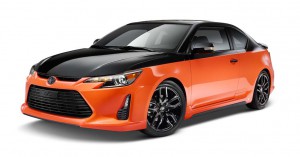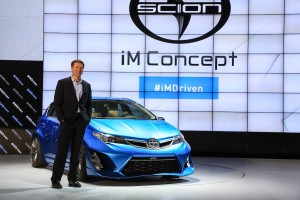Scion is turning to an old idea in its bid for young drivers, giving its tC Coupe a two-tone paint job based on a popular custom car show concept.
Originally aimed at youthful “influencers” who would draw buyers into showrooms for parent Toyota’s products, Scion has lost a lot of its early momentum in recent years, recent models like the micro-sized iQ and second-generation xB falling flat in the marketplace. Despite speculation Toyota might give up on the Scion brand-within-a-brand, the Japanese maker has no intention of pulling the plug and is, instead, promising to roll out an assortment of edgy new models that it hopes will recapture Scion’s original energy.
“We’re committed to Scion,” declared Bob Carter, head of Toyota’s U.S. auto operations, during a speech at an industry confab in San Francisco this week. The sub-brand remains “a test bed for Millennials,” and a significant part of Toyota’s broader strategy.
It sees Scion as a critical bridge to help it gain new buyers for the Toyota brand which has long been dependent on now-aging Baby Boomers.
With its “magma orange” and black paint scheme, the Scion tC Release Series 9.0 is based on a one-of concept by tuner firm Cartel Customs. Along with the distinctive colors, it will benefit from a large, tuner-style center exhaust pipe, alloy wheels, and an orange-accented interior.
“There won’t be a way to miss the Scion tC Release Series 9.0,” said Scion Vice President Doug Murtha. “This two-toned tC lets Scion fans have an everyday driver that looks like it’s straight out of a car show.”
The maker only expects to ship about 2,000 of the special models to U.S. dealers, with a base price of $23,960, including delivery charges.
But Scion has never aimed to be an ultra-high-volume brand like parent Toyota. Sales matter, no doubt, but the goal has been to create a high-visibility marque appealing to the youngest of new car buyers. And, in its early days – Scion debuting in 2002 – it delivered. Models like the original xB, a boxy microvan, clicked with 20- and 30-something buyers.
(Toyota teases radical new RND Concept. Click Here to check it out.)
What went wrong is a matter of debate, but the updated xB lost its allure. Scion hoped to become the brand of choice for hip, urban buyers with the iQ microcar, but it showed little more momentum than Daimler AG’s faltering Smart fortwo.
In its early days, Scion’s strategy called for having just three unique models in showrooms at any one time. The brand stretched that a bit with the arrival of the FR-S, an affordable sports car developed in cooperation with Japanese maker Subaru – and one of its few recent success stories.
Now, it may offer an even broader line-up as a mix of new products starts rolling into dealerships around the country. The maker is saying little about what it has in store, though it gave a hint with the unveiling of the Scion iM concept at the L.A. Auto Show last November. A production version is set to debut at the New York Auto Show in April.
(Click Hereto find out more about the Scion iM.)
Scion sales tumbled by 15.1% in 2014, to just 58,009. That made it one of the few losers in the industry’s best year since the Great Recession – and was barely half of what the brand sold at its peak in 2008. According to Scion VP Murtha, sales need to reach 100,000 annually to make Scion sustainable.
(Toyota breaks ground on new US HQ in Texas. Click Here for the story.)
Referring to Scion’s recent flops, Murtha recently told reporters, “We’ve learned lessons on all of those fronts and that’s going to influence how we approach vehicle development going forward.”
The first real test will come with the introduction of the Scion iM this spring.


